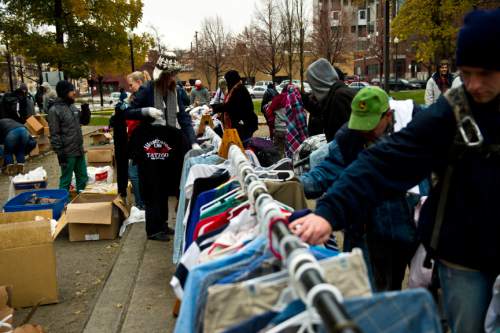This is an archived article that was published on sltrib.com in 2016, and information in the article may be outdated. It is provided only for personal research purposes and may not be reprinted.
The Salt Lake community has found the problem of homelessness on our streets an overwhelming humanitarian dilemma.
Uncertain of what is to be done, and who is responsible for doing it, we have long left much of the heavy lifting to a handful of struggling nonprofit organizations that have a full-time job just preventing the most vulnerable among us from freezing or starving for one more day.
In recent months, as the problem has become more visible and more of an impediment to plans to redevelop the area around Salt Lake City's Pioneer Park, various public and private officials and groups have delved into the issue.
The most comprehensive way forward so far was announced recently by Salt Lake County Mayor Ben McAdams. He calls it a Collective Impact approach. The key to it is to divide the problems of homelessness into more manageable slices and minutely measure the different factors that cause homelessness and the draft solutions, and to coldly evaluate the results for effectiveness and efficiency.
McAdams cares about all of this not just out of simple human decency, but also because the county is on the hook for the largest public expenditures made necessary by a large number of homeless people and families. Utah counties, with their own money and with federal grants, provide human services when they can, and jail cells when they must.
McAdams, wisely, wants to handle it all differently.
The mayor sees that too many people in crisis have, or know of, no other option but to present themselves at The Road Home shelter on Rio Grande Avenue and hope for the best. As a result, that overwhelmed service has become a frightening place, especially for women with children, as it has become a magnet for the mentally ill as well as for drug abusers and dealers.
Tops on McAdams' list is to, when possible, find families who are on the verge of losing their homes and provide financial and other services to prevent evictions. When it's too late for that, he wants to separate families with children from the single men and offer both the help they need, with some intensive case management, to get back on their feet. Or, at least, under a roof.
The plan envisions at least two new facilities at locations to be determined, to separate the populations and get a handle on each individual case. Salt Lake City officials are working on locations for these smaller shelters.
The mayor's plan will require money — some of which has been promised by the Utah Legislature, some that can be repurposed from existing county programs — and, more than that, active management and ongoing evaluation.
The constant flow of data that will be necessary to make all this work may seem an inhuman solution to a very human problem. But McAdams, good data geek that he is, knows it is the only way to really deal with the problem.



